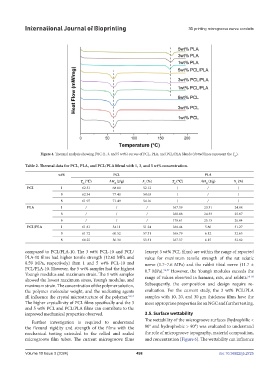Page 506 - IJB-10-3
P. 506
International Journal of Bioprinting 3D printing microgroove nerve conduits
Figure 4. Thermal analysis showing DSC (1, 3, and 5 wt%) curves of PCL, PLA, and PCL/PLA blends (dotted lines represent the T ).
m
Table 2. Thermal data for PCL, PLA, and PCL/PLA blend with 1, 3, and 5 wt% concentration.
wt% PCL PLA
T (℃) ΔH (J/g) X (%) T (℃) ΔH (J/g) X (%)
m m c m m c
PCL 1 62.51 68.80 52.12 / / /
3 62.34 77.40 58.63 / / /
5 61.97 71.49 54.16 / / /
PLA 1 / / / 167.59 23.31 24.88
3 / / / 168.88 24.33 25.97
5 / / / 170.61 25.15 26.84
PCL/PLA 1 61.81 54.11 51.24 166.44 5.86 31.27
3 61.72 60.52 57.31 166.79 6.12 32.65
5 60.25 56.30 53.31 167.37 6.15 32.82
compared to PCL/PLA-10. The 3 wt% PCL-10 and PCL/ (except 3 wt% PCL films) are within the range of reported
PLA-10 films had higher tensile strength (12.60 MPa and value for maximum tensile strength of the rat sciatic
8.59 MPa, respectively) than 1 and 5 wt% PCL-10 and nerve (1.7–7.6 MPa) and the rabbit tibial nerve (11.7 ±
PCL/PLA-10. However, the 5 wt% samples had the highest 0.7 MPa). 56,57 However, the Young’s modulus exceeds the
Young’s modulus and maximum strain. The 1 wt% samples 56-58
showed the lowest maximum stress, Young’s modulus, and range of values observed in humans, rats, and rabbits.
maximum strain. The concentration of the polymer solution, Subsequently, the composition and design require re-
the polymer molecular weight, and the nucleating agents evaluation. For the current study, the 3 wt% PCL/PLA
all influence the crystal microstructure of the polymer. 52,55 samples with 10, 20, and 30 µm thickness films have the
The higher crystallinity of PCL films specifically and the 3 most appropriate properties for an NGC and further testing.
and 5 wt% PCL and PCL/PLA films can contribute to the
improved mechanical properties observed. 3.5. Surface wettability
Further investigation is required to understand The wettability of the microgroove surfaces (hydrophilic <
the flexural rigidity and strength of the films with the 90° and hydrophobic > 90°) was evaluated to understand
mechanical testing extended to the rolled and sealed the role of microgroove topography, material composition,
microgroove film tubes. The current microgroove films and concentration (Figure 6). The wettability can influence
Volume 10 Issue 3 (2024) 498 doi: 10.36922/ijb.2725

